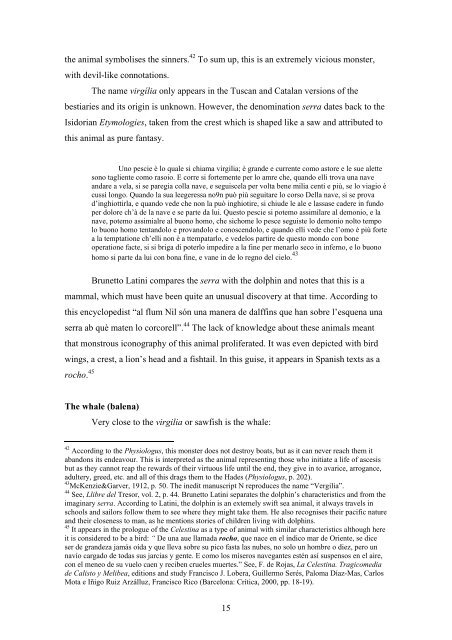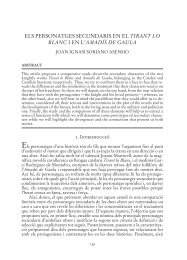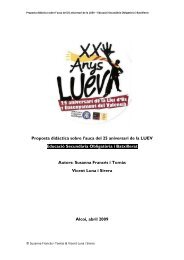Aquatic animals in the Catalan Bestiari - Institut Interuniversitari de ...
Aquatic animals in the Catalan Bestiari - Institut Interuniversitari de ...
Aquatic animals in the Catalan Bestiari - Institut Interuniversitari de ...
You also want an ePaper? Increase the reach of your titles
YUMPU automatically turns print PDFs into web optimized ePapers that Google loves.
<strong>the</strong> animal symbolises <strong>the</strong> s<strong>in</strong>ners. 42 To sum up, this is an extremely vicious monster,<br />
with <strong>de</strong>vil-like connotations.<br />
The name virgília only appears <strong>in</strong> <strong>the</strong> Tuscan and <strong>Catalan</strong> versions of <strong>the</strong><br />
bestiaries and its orig<strong>in</strong> is unknown. However, <strong>the</strong> <strong>de</strong>nom<strong>in</strong>ation serra dates back to <strong>the</strong><br />
Isidorian Etymologies, taken from <strong>the</strong> crest which is shaped like a saw and attributed to<br />
this animal as pure fantasy.<br />
Uno pescie è lo quale si chiama virgilia; è gran<strong>de</strong> e currente como astore e le sue alette<br />
sono tagliente como rasoio. E corre si fortemente per lo amre che, quando elli trova una nave<br />
andare a vela, si se paregia colla nave, e seguiscela per volta bene milia centi e più, se lo viagio è<br />
cussì longo. Quando la sua leegeressa no9n può più seguitare lo corso Della nave, si se prova<br />
d’<strong>in</strong>ghiottirla, e quando ve<strong>de</strong> che non la può <strong>in</strong>ghiotire, si chiu<strong>de</strong> le ale e lassase ca<strong>de</strong>re <strong>in</strong> fundo<br />
per dolore ch’à <strong>de</strong> la nave e se parte da lui. Questo pescie si potemo assimilare al <strong>de</strong>monio, e la<br />
nave, potemo assimialre al buono homo, che sichome lo pesce seguiste lo <strong>de</strong>monio nolto tempo<br />
lo buono homo tentandolo e provandolo e conoscendolo, e quando elli ve<strong>de</strong> che l’omo è più forte<br />
a la temptatione ch’elli non è a ttempatarlo, e ve<strong>de</strong>los partire <strong>de</strong> questo mondo con bone<br />
operatione facte, si si briga di poterlo impedire a la f<strong>in</strong>e per menarlo seco <strong>in</strong> <strong>in</strong>ferno, e lo buono<br />
homo si parte da lui con bona f<strong>in</strong>e, e vane <strong>in</strong> <strong>de</strong> lo regno <strong>de</strong>l cielo. 43<br />
Brunetto Lat<strong>in</strong>i compares <strong>the</strong> serra with <strong>the</strong> dolph<strong>in</strong> and notes that this is a<br />
mammal, which must have been quite an unusual discovery at that time. Accord<strong>in</strong>g to<br />
this encyclopedist “al flum Nil són una manera <strong>de</strong> dalff<strong>in</strong>s que han sobre l’esquena una<br />
serra ab què maten lo corcorell”. 44 The lack of knowledge about <strong>the</strong>se <strong>animals</strong> meant<br />
that monstrous iconography of this animal proliferated. It was even <strong>de</strong>picted with bird<br />
w<strong>in</strong>gs, a crest, a lion’s head and a fishtail. In this guise, it appears <strong>in</strong> Spanish texts as a<br />
rocho. 45<br />
The whale (balena)<br />
Very close to <strong>the</strong> virgilia or sawfish is <strong>the</strong> whale:<br />
42 Accord<strong>in</strong>g to <strong>the</strong> Physiologus, this monster does not <strong>de</strong>stroy boats, but as it can never reach <strong>the</strong>m it<br />
abandons its en<strong>de</strong>avour. This is <strong>in</strong>terpreted as <strong>the</strong> animal represent<strong>in</strong>g those who <strong>in</strong>itiate a life of ascesis<br />
but as <strong>the</strong>y cannot reap <strong>the</strong> rewards of <strong>the</strong>ir virtuous life until <strong>the</strong> end, <strong>the</strong>y give <strong>in</strong> to avarice, arrogance,<br />
adultery, greed, etc. and all of this drags <strong>the</strong>m to <strong>the</strong> Ha<strong>de</strong>s (Physiologus, p. 202).<br />
43 McKenzie&Garver, 1912, p. 50. The <strong>in</strong>edit manuscript N reproduces <strong>the</strong> name “Vergilia”.<br />
44 See, Llibre <strong>de</strong>l Tresor, vol. 2, p. 44. Brunetto Lat<strong>in</strong>i separates <strong>the</strong> dolph<strong>in</strong>’s characteristics and from <strong>the</strong><br />
imag<strong>in</strong>ary serra. Accord<strong>in</strong>g to Lat<strong>in</strong>i, <strong>the</strong> dolph<strong>in</strong> is an extemely swift sea animal, it always travels <strong>in</strong><br />
schools and sailors follow <strong>the</strong>m to see where <strong>the</strong>y might take <strong>the</strong>m. He also recognises <strong>the</strong>ir pacific nature<br />
and <strong>the</strong>ir closeness to man, as he mentions stories of children liv<strong>in</strong>g with dolph<strong>in</strong>s.<br />
45 It appears <strong>in</strong> <strong>the</strong> prologue of <strong>the</strong> Celest<strong>in</strong>a as a type of animal with similar characteristics although here<br />
it is consi<strong>de</strong>red to be a bird: “ De una aue llamada rocho, que nace en el índico mar <strong>de</strong> Oriente, se dice<br />
ser <strong>de</strong> gran<strong>de</strong>za jamás oída y que lleva sobre su pico fasta las nubes, no solo un hombre o diez, pero un<br />
navío cargado <strong>de</strong> todas sus jarcias y gente. E como los míseros navegantes estén así suspensos en el aire,<br />
con el meneo <strong>de</strong> su vuelo caen y reciben crueles muertes.” See, F. <strong>de</strong> Rojas, La Celest<strong>in</strong>a. Tragicomedia<br />
<strong>de</strong> Calisto y Melibea, editions and study Francisco J. Lobera, Guillermo Serés, Paloma Díaz-Mas, Carlos<br />
Mota e Iñigo Ruiz Arzálluz, Francisco Rico (Barcelona: Crítica, 2000, pp. 18-19).<br />
15




